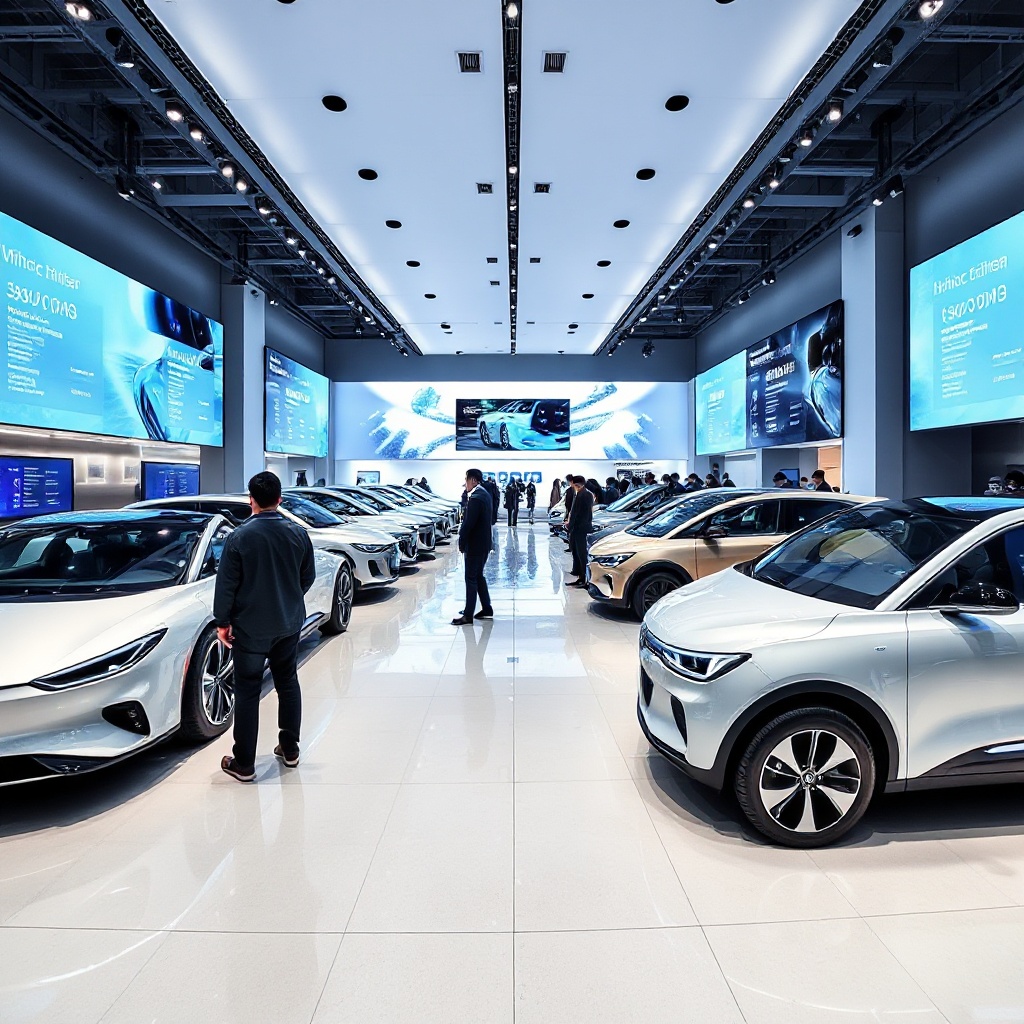
China's EV makers dominate global markets with tech-forward, affordable electric vehicles, capturing 70% of production and forcing competitors to adapt or risk obsolescence.

Drivetech Partners
China's electric vehicle manufacturers have revolutionized the global automotive landscape by combining cutting-edge technology with aggressive pricing strategies that established competitors struggle to match. Chinese brands now dominate EV production worldwide, capturing significant market share across continents while forcing traditional automakers to accelerate their own electric transition plans or risk becoming obsolete.
Key Takeaways
China accounts for over 70% of global EV production in 2024, with Chinese brands holding six of the top ten global sales positions
Chinese EVs typically sell at thousands of dollars less than comparable Western models while offering equal or superior technology
BYD has achieved 397% year-on-year growth in European registrations, exemplifying Chinese brands' rapid international expansion
Rising trade barriers in Western markets are prompting Chinese manufacturers to establish overseas production facilities
The competitive pressure is forcing all automakers to improve technology offerings and reconsider pricing strategies
China's Dominant Position in the Global EV Market
The numbers tell a compelling story about China's electric vehicle supremacy. Chinese manufacturers now account for over 70% of global electric car production in 2024, with Chinese OEMs responsible for more than 80% of this output—a significant increase from roughly two-thirds in 2021. The country is on track to sell more than 14 million EVs in 2025, representing nearly 50% of China's total car sales and approximately two-thirds of global EV sales.
BYD has emerged as a dominant global force, holding 22% of the global plug-in electric vehicle market share. While Tesla still leads in battery electric vehicles, BYD dominates in plug-in hybrids with a 19.6% market share. The first quarter of 2025 saw Chinese brands capture six of the top ten spots for global EV sales, highlighting their growing international presence.
Key players leading this expansion include BYD, MG (SAIC), GWM, Leapmotor, Jaecoo, Omoda, and Chery. These manufacturers have successfully leveraged their domestic market advantages to build global momentum, establishing new benchmarks for what consumers can expect from electric vehicles.
The Competitive Edge: Affordable High-Tech EVs

The key to Chinese manufacturers' success lies in their ability to offer high-tech features at lower prices. Chinese EVs typically cost several thousand dollars less than equivalent Western or Japanese models, a price advantage stemming from advanced domestic supply chains, mass production efficiencies, and state support.
In China, battery electric cars often reach or even fall below price parity with conventional vehicles before any incentives are applied. This remarkable achievement has altered consumer expectations globally, as buyers now demand more value for their money.
Advanced features that were once considered premium extras have become standard in Chinese models, including:
Over-the-air (OTA) software updates
Sophisticated in-car infotainment systems
Extended driving range
Faster charging capabilities
AI-driven systems and automation
The quick introduction of alternative powertrain options (plug-in and full hybrids) is also accelerating the market transition away from internal combustion engines, particularly in price-sensitive markets where full electric infrastructure remains limited.
Global Expansion and Market Penetration
Chinese brands are rapidly gaining ground in markets beyond their borders. In the European Union, Chinese manufacturers doubled their market share to 5.9% in May 2025, up from just 2.9% a year earlier. BYD's registrations in Europe surged by an astounding 397% year-on-year in May 2025, while MG (owned by China's SAIC) surpassed established brand Fiat in annual registrations during the same period.
The impact is even more pronounced in emerging markets. In Brazil and Thailand, up to 85% of new EVs sold in 2024-2025 were Chinese imports. Though exports from China are increasing, they still represent a minority of total output, with less than 2% of Chinese OEM EV production occurring outside China as of 2024.
This global market penetration has forced established automakers to accelerate their own electric vehicle programs and reconsider their pricing strategies. The competitive pressure has become particularly acute in Europe, where Chinese brands have made significant inroads despite increasing regulatory barriers.
Rising Trade Barriers and Regulatory Challenges
As Chinese EVs gain market share, protectionist responses have intensified. The European Union imposed specific countervailing duties on Chinese BEV imports in 2024, while the United States and Canada raised tariffs above 100%, with the US adding further hikes in 2025, effectively excluding most Chinese EVs from these markets.
Emerging markets have also implemented protective measures. Brazil and Mexico have reintroduced and raised import tariffs, with Brazil phasing in a 35% rate by mid-2026. Mexico ended a 15-20% tariff exemption for Chinese imports that had previously facilitated market entry.
These trade actions are driving Chinese OEMs to establish overseas production facilities. BYD and Great Wall Motor (GWM) are building factories in Brazil and other markets to circumvent import restrictions while maintaining their competitive advantages. This adaptation strategy demonstrates the agility and determination of Chinese manufacturers to maintain their global expansion despite regulatory headwinds.
Strategic Responses to Market Barriers
Chinese manufacturers are rapidly adapting their strategies in response to these challenges. Their multi-faceted approach includes cost management, innovation acceleration, and global expansion through various channels.
Establishing local production facilities has become a key tactic to circumvent tariffs and import restrictions. BYD and other manufacturers are building factories in Brazil, Thailand, and European markets, creating jobs and forging political goodwill while maintaining their market presence.
Technological innovation continues at a rapid pace to ensure that Chinese brands maintain competitive advantages beyond just price. Companies are also developing market-specific models tailored to regional preferences and regulations, showing a sophisticated understanding of global markets that was previously lacking.
These adaptive strategies demonstrate resilience in the face of trade barriers, suggesting that Chinese manufacturers are committed to long-term global presence rather than quick market entry and exit.
Shifting Consumer Expectations Worldwide
The entry of Chinese EVs into global markets has fundamentally altered consumer expectations. Global car buyers now expect advanced technology features, better software, and more competitive pricing regardless of a vehicle's origin.
Western, Japanese, and Korean OEMs have been forced to innovate faster, cut costs, and reconsider their supply chain strategies. There's a growing consumer preference for software-defined vehicles with frequent updates and connected features, areas where Chinese manufacturers have excelled.
Expectations regarding charging speed, range, and in-car technology have also evolved, pushing all manufacturers to improve their offerings. Price sensitivity has increased as more affordable options enter markets, creating pressure on established brands to justify their premium pricing.
This shift represents a democratization of technology that benefits consumers worldwide while creating significant challenges for legacy automakers accustomed to commanding price premiums.
Market Growth and Future Uncertainty

The global EV market continued its upward trajectory with 28% growth in 2025, with Chinese manufacturers increasing their market share faster than competitors. However, this growth is increasingly concentrated in China, with other major markets experiencing slower expansion.
Regulatory changes, the end of generous incentives, and rising trade friction are creating uneven global growth patterns. Fluctuating government subsidy programs add another layer of market unpredictability, with examples including China's CNY 20,000 per car stimulus and various incentives in Thailand and Brazil.
Established automakers are reassessing their investment strategies as the competitive landscape evolves. Some are accelerating their EV programs, while others are hedging their bets with hybrid technologies or extending the life of combustion engine platforms.
The future remains uncertain for the global EV sector, with significant variation in growth rates by region. China continues to maintain stronger momentum than Europe or North America, potentially widening the gap between Chinese manufacturers and their global competitors.
The Evolving Competitive Landscape
The global automotive industry is experiencing unprecedented disruption as established players face new competition from Chinese EV manufacturers. Western and Japanese automakers are accelerating EV development and cost-cutting initiatives, but many struggle to match the price-to-feature ratio of Chinese competitors.
Industry consolidation appears increasingly likely as some players struggle to compete on price and technology. We're already seeing supply chain shifts as manufacturers seek to reduce dependence on Chinese components, though this often comes with higher costs.
Market growth rates vary significantly by region, with China maintaining stronger momentum than Europe or North America. This uneven development creates additional challenges for global automakers trying to optimize their production and distribution networks.
The coming years will likely see continued flux in market dynamics, with Chinese brands gaining ground in regions where trade barriers remain lower while established automakers fight to maintain their positions in protected markets. The ultimate winners in this competitive reshaping will be those who can balance innovation, cost efficiency, and regulatory compliance across diverse global markets.
Sources
tridenstechnology.com - BYD Sales Statistics
iea.org - Global EV Outlook 2025: Trends in Electric Car Markets
iea.org - Global EV Outlook 2025: Trends in the Electric Car Industry
jato.com - Chinese Automakers Double European Market Share in May
source.benchmarkminerals.com - Global EV Sales Grow 28% in 2025
autovista24.autovistagroup.com - China Starts 2025 at the Front of the Global EV Market
autovista24.autovista




